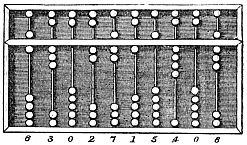History of computing hardware
History of Computing Hardware
The history of computing hardware covers the developments from early simple devices to aid calculation to modern day computers. Before the 20th century, most calculations were done by humans. Early mechanical tools to help humans with digital calculations, such as the abacus, were referred to as calculating machines or calculators (and other proprietary names). The machine operator was called the computer.
Pre-20th Century[edit | edit source]
The history of computing hardware is rooted in the desire for automated calculation, which began with the use of the abacus, invented in Sumer around 2500 BC. This desire led to the development of various mechanical calculating devices over the centuries. In 1642, Blaise Pascal invented the Pascaline, an early calculating machine that could perform addition and subtraction directly and multiplication and division by repetition.
Gottfried Wilhelm Leibniz improved on Pascal's designs and built a mechanical calculator that could perform all four arithmetic operations. His stepped reckoner, developed around 1672, is considered an early precursor to the modern computer. However, these mechanical calculators were limited in their functionality and were not widely adopted.
19th Century[edit | edit source]
The 19th century saw significant advancements in computing hardware. The most notable was the invention of the Difference Engine and the Analytical Engine by Charles Babbage. The Difference Engine was designed to calculate mathematical tables, while the Analytical Engine, conceived in 1837, was intended to be a more general-purpose computing device. The Analytical Engine is celebrated as the first design for a modern computer, featuring components analogous to a CPU, memory, and input/output devices.
Although Babbage's machines were never completed during his lifetime, they laid the groundwork for the future of computing. Ada Lovelace, who worked with Babbage, is credited with writing the first algorithm intended to be processed by a machine, making her the world's first computer programmer.
20th Century[edit | edit source]
The 20th century witnessed the rapid evolution of computing hardware, driven by the increasing demand for automation and computational power. The development of electronic computers began in the 1930s and 1940s with machines such as the Z3 by Konrad Zuse, the Colossus used by British codebreakers during World War II, and the ENIAC, which was one of the first electronic general-purpose computers.
These early computers were enormous, taking up entire rooms, and were limited in their programming capabilities. The invention of the transistor in 1947 by William Shockley, John Bardeen, and Walter Brattain at Bell Labs marked a turning point in computing hardware. Transistors led to the development of smaller, more efficient, and more reliable computers.
The introduction of the integrated circuit (IC) by Jack Kilby and Robert Noyce in the late 1950s further revolutionized computing hardware, leading to the development of the microprocessor in the early 1970s. The microprocessor was a significant milestone, enabling the creation of personal computers and the beginning of the Information Age.
Modern Era[edit | edit source]
Today, computing hardware continues to evolve at a rapid pace, with advancements in quantum computing, artificial intelligence, and nanotechnology. The focus has shifted towards making computing devices smaller, faster, and more energy-efficient.
The history of computing hardware is a testament to human ingenuity and the relentless pursuit of knowledge and innovation. It reflects the evolution of technology from mechanical devices to electronic machines that have become an integral part of daily life.
Search WikiMD
Ad.Tired of being Overweight? Try W8MD's physician weight loss program.
Semaglutide (Ozempic / Wegovy and Tirzepatide (Mounjaro / Zepbound) available.
Advertise on WikiMD
|
WikiMD's Wellness Encyclopedia |
| Let Food Be Thy Medicine Medicine Thy Food - Hippocrates |
Translate this page: - East Asian
中文,
日本,
한국어,
South Asian
हिन्दी,
தமிழ்,
తెలుగు,
Urdu,
ಕನ್ನಡ,
Southeast Asian
Indonesian,
Vietnamese,
Thai,
မြန်မာဘာသာ,
বাংলা
European
español,
Deutsch,
français,
Greek,
português do Brasil,
polski,
română,
русский,
Nederlands,
norsk,
svenska,
suomi,
Italian
Middle Eastern & African
عربى,
Turkish,
Persian,
Hebrew,
Afrikaans,
isiZulu,
Kiswahili,
Other
Bulgarian,
Hungarian,
Czech,
Swedish,
മലയാളം,
मराठी,
ਪੰਜਾਬੀ,
ગુજરાતી,
Portuguese,
Ukrainian
Medical Disclaimer: WikiMD is not a substitute for professional medical advice. The information on WikiMD is provided as an information resource only, may be incorrect, outdated or misleading, and is not to be used or relied on for any diagnostic or treatment purposes. Please consult your health care provider before making any healthcare decisions or for guidance about a specific medical condition. WikiMD expressly disclaims responsibility, and shall have no liability, for any damages, loss, injury, or liability whatsoever suffered as a result of your reliance on the information contained in this site. By visiting this site you agree to the foregoing terms and conditions, which may from time to time be changed or supplemented by WikiMD. If you do not agree to the foregoing terms and conditions, you should not enter or use this site. See full disclaimer.
Credits:Most images are courtesy of Wikimedia commons, and templates, categories Wikipedia, licensed under CC BY SA or similar.
Contributors: Prab R. Tumpati, MD





